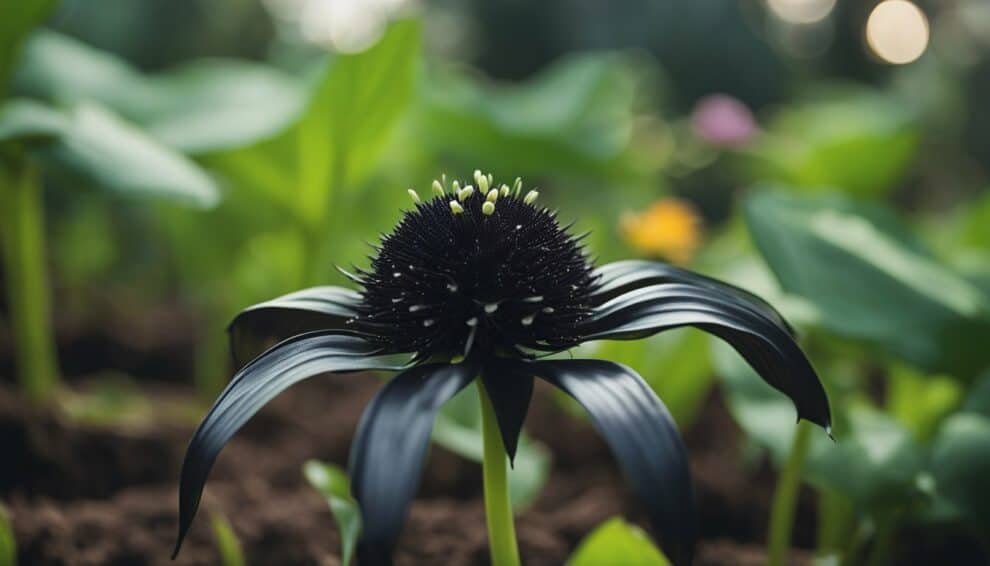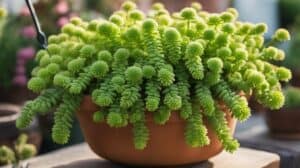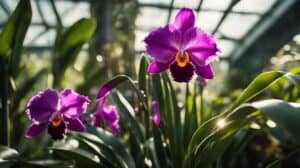Tacca chantrieri, commonly known as the Black Bat Flower, is a unique and exotic plant that is native to Southeast Asia.
This plant is named after its distinctive flowers, which resemble a bat in flight, and is highly sought after by collectors and garden enthusiasts due to its striking appearance.
However, cultivating Tacca chantrieri can be challenging, and requires a specialized approach to ensure its successful propagation.

Propagation of the Black Bat Flower can be achieved through a variety of methods, including seed germination, division of rhizomes, and stem cuttings.
However, each method has its own unique set of challenges and requires careful attention to detail to ensure success.
Seed germination, for example, can be difficult due to the plant’s slow growth rate and susceptibility to fungal infections.
On the other hand, division of rhizomes can be tricky due to the plant’s delicate root system, which can easily be damaged during the process.
Despite the challenges involved in cultivating Tacca chantrieri, the rewards are well worth the effort.
With its striking flowers and unique appearance, the Black Bat Flower is sure to be a conversation starter and a standout addition to any garden or collection.
In the following article, we will explore the various methods of Black Bat Flower propagation and provide tips and tricks for ensuring success.
Understanding Tacca Chantrieri
Tacca chantrieri, commonly known as the Black Bat Flower, is a tropical plant species that belongs to the family Dioscoreaceae.
This plant is native to Southeast Asia, particularly Thailand and Malaysia.
It is a unique plant with distinctive features that make it a favorite among gardeners.
The Black Bat Flower is a perennial plant that grows up to 3 feet tall. It has large, dark green leaves that can reach up to 2 feet in length.
The flowers of the Black Bat Flower are the main attraction. They are shaped like a bat, with long, thin petals that resemble whiskers.
The flowers can grow up to 12 inches in diameter and come in shades of black, purple, and occasionally green.
Propagation of Tacca chantrieri can be challenging, but it is possible with the right techniques.
The most common method of propagation is through rhizome division. Rhizomes are underground stems that produce new shoots and roots.
Dividing the rhizomes is done during the plant’s dormant season, which is usually in the fall or winter.
Another method of propagation is through seed germination.
However, this method is less reliable, and it can take up to two years for the plant to produce flowers.
Overall, Tacca chantrieri is a unique and fascinating plant that requires special care and attention.
With proper propagation techniques, this plant can thrive and add a touch of exotic beauty to any garden.
Propagation Basics

Black bat flowers can be propagated through two methods: seed propagation and division method.
Seed Propagation
Seed propagation is the most common method of propagating black bat flowers.
Seeds can be collected from mature flowers and sown immediately or stored for up to six months.
To sow the seeds, fill a pot with a well-draining soil mix and sprinkle the seeds on top. Cover with a thin layer of soil and mist with water.
Keep the pot in a warm and humid location, and the seeds should germinate within 2-4 weeks.
Once the seedlings have grown to a few inches tall, they can be transplanted into individual pots.
Division Method
The division method is another way to propagate black bat flowers. This method is best done in the spring when the plant is actively growing.
To propagate through division, carefully remove the plant from its pot and gently separate the rhizomes.
Each division should have at least one healthy stem and root system.
Plant the divisions in individual pots filled with well-draining soil mix.
Water thoroughly and keep the pots in a warm and humid location until new growth appears.
Propagation through division can be done every few years to maintain the health and vigor of the plant.
Caring for Your Propagated Black Bat Flower

Soil Requirements
The Black Bat Flower thrives in well-draining soil that is rich in organic matter. A mixture of peat moss, perlite, and vermiculite is ideal for this plant.
The soil should be kept moist, but not waterlogged, as the Black Bat Flower is susceptible to root rot.
Watering and Humidity
The Black Bat Flower requires regular watering to keep the soil moist.
However, overwatering can lead to root rot, so it is important to avoid getting the soil too wet.
The plant also prefers high humidity levels, so misting the leaves with water can help to keep it healthy.
Light and Temperature
The Black Bat Flower prefers bright, indirect light, but can also tolerate some shade.
Direct sunlight can scorch the leaves, so it is best to avoid placing it in direct sunlight.
The plant also prefers warm temperatures, between 65-85°F (18-29°C).
Overall, caring for a propagated Black Bat Flower is relatively easy as long as you provide it with the right growing conditions.
With proper care, your Black Bat Flower will produce stunning blooms that will add a touch of exotic beauty to your home or garden.
Troubleshooting Common Issues

Pest and Disease Management
Black Bat Flower is generally a hardy plant, but it is still susceptible to pests and diseases.
Some of the common pests that may attack this plant include spider mites, mealybugs, and thrips.
To prevent these pests from damaging your plant, it is important to keep it clean and well-ventilated.
If you notice any signs of infestation, such as yellowing leaves or webbing, you should take action immediately.
One effective way to control pests is to spray the plant with a solution of neem oil and water.
This will help to kill the pests and prevent them from spreading to other plants.
Another option is to use an insecticidal soap, which can be applied directly to the affected areas.
In terms of diseases, Black Bat Flower is susceptible to root rot if it is overwatered or planted in poorly-draining soil.
To prevent this, make sure to water the plant only when the top inch of soil is dry.
If you notice any signs of root rot, such as wilting or yellowing leaves, you should remove the affected parts of the plant and repot it in fresh soil.
Propagation Challenges
Propagation of Black Bat Flower can be challenging, as it requires specific conditions to thrive.
One of the most common challenges is germination, as the seeds can take up to six months to sprout.
To increase the chances of successful germination, it is recommended to soak the seeds in warm water for 24 hours before planting them in a well-draining soil mix.
Another challenge is maintaining the proper humidity and temperature for the plant to grow.
Black Bat Flower prefers warm, humid environments, so it is important to keep it in a greenhouse or other enclosed space with high humidity levels.
It is also important to avoid overwatering the plant, as this can lead to root rot and other issues.
Overall, with proper care and attention, Black Bat Flower can be a beautiful addition to any garden or indoor space.
By following the tips outlined above, you can ensure that your plants remain healthy and vibrant for years to come.
Frequently Asked Questions

What is the best method to propagate a Black Bat Flower?
The most effective way to propagate a Black Bat Flower is through division.
This involves carefully separating the plant’s rhizomes and planting them in separate pots.
It is best to do this in the spring when the plant is actively growing.
Can I propagate Tacca chantrieri in water, and if so, how?
While it is possible to propagate Black Bat Flowers in water, it is not recommended.
The plant prefers well-draining soil and too much moisture can lead to root rot. It is best to stick to the division method for propagation.
What are the ideal conditions for growing a Black Bat Flower indoors?
Black Bat Flowers prefer bright, indirect light and high humidity. They also require well-draining soil and should be watered regularly but not overwatered.
The ideal temperature range for this plant is between 65-80°F.
Is the Black Bat Flower toxic to pets or humans?
While the Black Bat Flower is not considered highly toxic, it can cause skin irritation and mild gastrointestinal upset if ingested.
It is best to keep this plant out of reach of children and pets.
What are some interesting facts about the Black Bat Flower?
The Black Bat Flower is also known as the Devil Flower or the Bat Head Lily.
It is native to Southeast Asia and is often associated with Halloween due to its unique appearance.
The plant is also used in traditional medicine to treat a variety of ailments.
How should I repot my Black Bat Flower to ensure its health and growth?
It is recommended to repot your Black Bat Flower every 2-3 years. Choose a pot that is slightly larger than the current one and use a well-draining soil mix.
Carefully remove the plant from its current pot and gently loosen the roots before placing it in the new pot.
Water thoroughly and allow the plant to adjust to its new environment.













